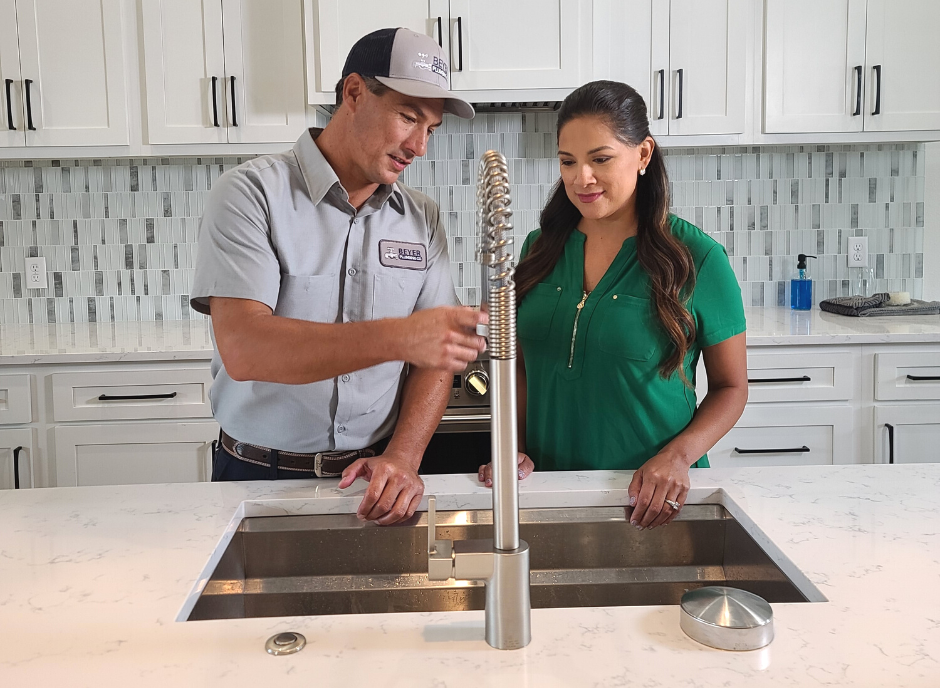How It's Vital to Fix a Faulty Faucet
How It's Vital to Fix a Faulty Faucet
Blog Article
What are your ideas on What Causes Leaky Faucets & How To Fix Them?

Dripping faucets might look like a small aggravation, but their impact goes beyond just the inconvenience of the noise. From wasting water to incurring unnecessary monetary expenses and health dangers, neglecting a dripping tap can result in various effects. In this article, we'll explore why it's essential to resolve this typical home problem quickly and efficiently.
Wastage of Water
Environmental Influence
Trickling faucets contribute significantly to water wastefulness. According to the Epa (EPA), a single tap trickling at one drip per second can waste greater than 3,000 gallons of water annually. This not only pressures water resources yet likewise influences communities and wildlife depending on them.
Step-by-Step Guide to Dealing With a Dripping Faucet
Devices Required
Prior to attempting to take care of a dripping faucet, collect the required devices, consisting of a flexible wrench, screwdrivers, substitute parts (such as washing machines or cartridges), and plumber's tape.
Common Faucet Issues and Their Solutions
Determine the sort of tap and the specific problem triggering the drip. Typical troubles consist of damaged washing machines, rusty valve seats, or defective O-rings. Refer to producer directions or on the internet tutorials for step-by-step assistance on repair work.
Financial Expenses
Enhanced Water Bills
Beyond the ecological influence, leaking faucets can inflate water costs considerably. The accumulated wastefulness with time equates into greater energy expenses, which can have been prevented with timely fixings.
Prospective Home Damage
In addition, extended trickling can cause harm to components and surfaces bordering the faucet. Water build-up can cause staining, deterioration, and even architectural issues if left ignored, causing additional repair service costs.
Health and wellness Problems
Mold and Mildew Development
The constant existence of wetness from a trickling faucet creates a suitable environment for mold and mildew growth. These fungi not only endanger indoor air quality but additionally pose health dangers, especially for people with breathing conditions or allergies.
Waterborne Diseases
Stationary water in trickling taps can become a breeding ground for bacteria and other pathogens, increasing the risk of waterborne conditions. Pollutants such as Legionella germs thrive in stationary water, possibly resulting in serious illnesses when consumed or inhaled.
Do it yourself vs. Expert Repair
Pros and Cons of DIY Fixing
While some may try to repair a trickling faucet themselves, do it yourself repair work feature their own collection of obstacles. Without appropriate expertise and tools, do it yourself attempts can intensify the concern or lead to incomplete fixings, prolonging the problem.
Benefits of Working With a Specialist Plumber
Hiring a professional plumber makes sure that the underlying source of the trickling tap is dealt with efficiently. Plumbing professionals possess the competence and tools to detect and fix tap concerns successfully, conserving time and minimizing the threat of more damages.
Ecological Duty
Specific Payment to Preservation
Taking obligation for taking care of leaking faucets aligns with broader initiatives towards water conservation and environmental sustainability. Every person's activities collectively make a significant influence on protecting precious sources.
Lasting Living Practices
By prioritizing prompt fixings and embracing water-saving habits, people contribute to lasting living practices that profit both present and future generations.
Safety nets
Regular Upkeep Tips
To prevent leaking taps, carry out regular maintenance such as cleansing aerators, examining for leakages, and replacing worn-out components promptly. Furthermore, take into consideration installing water-saving gadgets or updating to more effective components.
Relevance of Prompt Repairs
Dealing with leaking taps as quickly as they're discovered stops additional water wastefulness and prospective damages, inevitably saving both water and cash in the future.
Influence On Residential Property Worth
Assumption of Well-Maintained Property
Maintaining a property in good condition, including addressing maintenance concerns like leaking taps, improves its perceived value and value amongst prospective customers or renters.
Impact on Resale Value
Features with well-kept plumbing components, including faucets, command higher resale worths in the real estate market. Dealing with trickling taps can contribute to a positive perception throughout residential or commercial property examinations and arrangements.
Conclusion
Dealing with a leaking faucet exceeds simple convenience; it's an important step toward conserving water, decreasing financial costs, and protecting health and home. Whether through DIY repairs or specialist aid, acting to repair leaking faucets is a tiny yet impactful method to promote responsible stewardship of sources and contribute to a much healthier, a lot more sustainable future.
How to Fix a Leaky Faucet: Step-by-Step Repair Guide
A leaky faucet may seem like a simple annoyance, but if it's not fixed promptly, that leak could cost hundreds to potentially thousands. From water damage to mold, mildew, and high water bills, even a tiny leak can be catastrophic if left unattended. Damage like this can even affect the overall value of your home, so it's important to take the right approach for leaky faucet repair. You may need the help of a plumber in some cases, but we've got a few tips you can try on how to fix a leaky faucet before calling the pros.
Four Faucet Types
When you're learning how to fix a leaky faucet, the first step is knowing what kind of faucet you're working with! There are four common types.
Cartridge Faucets
Cartridge faucets come in one- or two-handled varieties. In one-handled cartridge faucets, hot and cold water combines in a single cartridge. In the two-handled versions, hot and cold water are controlled separately and mixed in the faucet.
Ball Faucets
Ball faucets have a single lever you push up and down to adjust the pressure and rotate to change the temperature. A slotted metal ball controls the amount of water allowed into the spout.
Compression Washer Faucets
They're the oldest type of faucet, but they're still used in many homes — especially older ones. Compression faucets have two separate handles that, when turned, raise or lower the washer that seals a water valve. This valve stops water from flowing through the faucet when it is turned off.
Disc Faucets
Disc faucets rarely need to be repaired due to their maintenance-free design. The water flow is controlled by two discs — the upper one raises and lowers against a fixed lower disc, creating a watertight seal. If your disc faucet starts leaking, you may need to replace the seals or clean residue buildup from the inlets.
Fixing a Leaky Faucet
Step 1: Turn Off the Water
Whether you're learning how to fix a leaky bathtub faucet or how to fix a leaky kitchen faucet, always turn off the water supply to your working area when you're fixing a leak. The last thing you want is a flood added to your list of things to fix.
Look for the shutoff valves below your sink or around the tub and turn them clockwise to stop the water flow. If your faucet doesn't have shutoff valves, you may need to turn off the water for the whole house. Check to make sure it's off by turning the faucet on. If nothing comes out, you're ready to start the repair.
Step 2: Take Apart the Faucet
How you disassemble your faucet depends on the type of fixture you have. You can use a flathead screwdriver to remove the caps on top of the handle or handles for cartridge and compression faucets. Inside, you should see handle screws. Unscrew these with a screwdriver to remove the handle.
Disc- and ball-style faucets will typically have an inlet screw near the handle, and removing that will reveal the interior of the faucet.
Detach the Valve Stem
For cartridge- and compression-style faucets, you'll see the inner valve stem or cartridge once you remove the faucet handles. If you have a compression faucet, unscrew the brass valve stem. If you have a cartridge faucet, pull out the cartridge. If your cartridge has been in place for a while, it may require some tools or extra force to remove it due to mineral deposits.
Examine and Replace Parts
Once you've removed the parts, check them out to confirm what needs to be replaced. You may see corroded rubber washers, O-rings, stems, or cartridges. On a ball-style faucet, check the seats and springs for damage.
If you need to repair a leaky disc faucet, check the inlet and seals on the lower disc.
Once you determine what parts must be replaced, visit your local hardware store. Bring the damaged parts with you to ensure you can purchase the correct components to replace them.
Clean Valves and Faucet Cavity
If you've removed a stem or cartridge, you may notice mineral buildup in the faucet's threads. Use white vinegar to clean the valve seat by soaking it for a few minutes, then scrub it away with a soft toothbrush and rinse with warm water. You can also clean the interior of the faucet in the same way.
Reassemble the Faucet
Once your faucet is cleaned and the required parts have been replaced, it's time to reassemble it. Put the pieces back together and slowly turn the water supply back on. Doing this slowly is crucial because too much initial water pressure can damage the new hardware you've just installed.
https://homewarranty.firstam.com/blog/how-to-fix-leaky-faucet

I ran across that piece of writing about Leaky Faucets: Why They Happen & What to Do About Them when looking around the search engines. Sharing is nice. Helping people is fun. I take joy in reading our article about Should I Repair or Replace a Leaky Faucet?.
Report this page